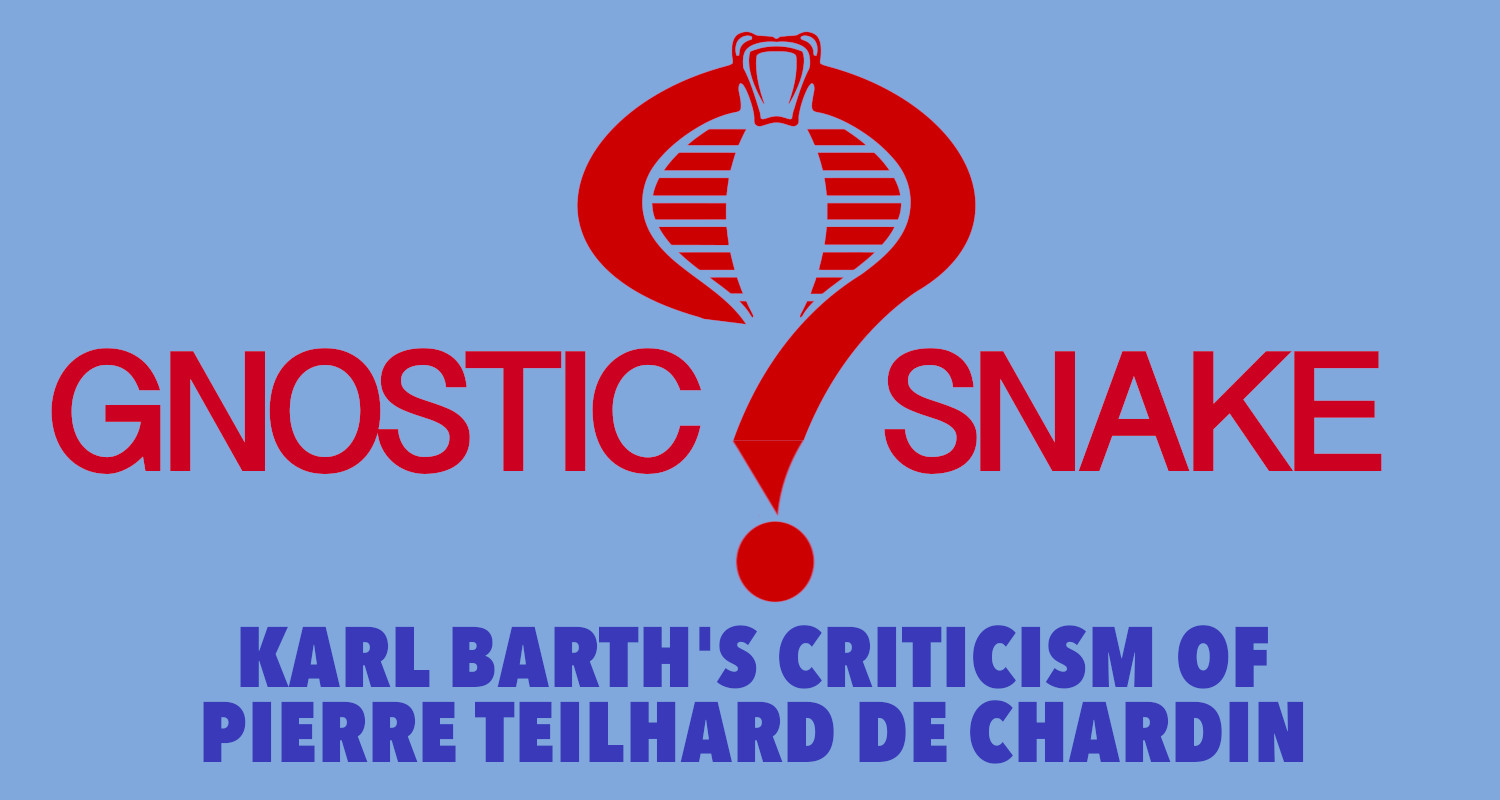 Karl Barth wrote two famous letters in August 1963 wherein he condemned Pierre Teilhard de Chardin SJ (1881 – 1955) as a "giant gnostic snake" that has swallowed up Jesus Christ in order to worship the "deity of evolution", and that Emil Brunner is a "harmless blind-worm" in comparison to Teilhard de Chardin! These two letters were written by Barth in the 1960's, after he had completed his maturest theological works, and have caused Teilhard de Chardin to receive a bad reputation. I've included the relevant selections from these two letters below.
Karl Barth wrote two famous letters in August 1963 wherein he condemned Pierre Teilhard de Chardin SJ (1881 – 1955) as a "giant gnostic snake" that has swallowed up Jesus Christ in order to worship the "deity of evolution", and that Emil Brunner is a "harmless blind-worm" in comparison to Teilhard de Chardin! These two letters were written by Barth in the 1960's, after he had completed his maturest theological works, and have caused Teilhard de Chardin to receive a bad reputation. I've included the relevant selections from these two letters below.
In Defense of Pierre Teilhard de Chardin SJ
Teilhard de Chardin was a Jesuit priest and theologian, and his most famous works were published posthumously because his theology was also harshly criticized by the Roman Catholic Church, especially due to his embrace of evolution and criticism of original sin, including his The Phenomenon of Man (1955), and The Divine Milieu (1957) mentioned by Barth in these two letters, etc. Teilhard was an accomplished paleontologist, and participated in the unearthing of the Peking Man, and studied first hand at the Piltdown Man discovery site and the discovery of Australopithecus. Teilhard was bold and brave enough to open his eyes to these remarkable specimens of human evolution and embrace them within his Jesuit theology a hundred years ago. He forged a theology that embraced evolution within Catholic theology that many theologians have emulated and developed, including Karl Rahner who wrote a short book titled Hominsation—a word invented by Teilhard de Chardin.
In Criticism of Karl Barth
I agree with Karl Barth's rejection of Natural Revelation, but his criticism of Teilhard is unfair considering that Barth affirmed evolution, and he developed his own natural theology in CD IV/3 that he called "secular parables of the truth" that allowed for lesser lights in the natural world within the light of Jesus Christ. So, Barth's criticism of Teilhard using light-metaphors is a double standard. Additionally, Barth's harsh comment against Brunner against Teilhard is betrayed by Barth's final word to Brunner: "Yes to Us All" in a 1966 letter to Brunner in which Barth wrote to Brunner: "And tell him the time when I thought I should say No to him is long since past".
Additionally, Barth's Doctrine of Creation in the Church Dogmatics III has been perennially criticized for virtually nil engagement with the discoveries of modern science that has continuously ailed the Christian Church's theology. An oversight that Barth's greatest disciples—including T. F. Torrance—strived to overcome.
Karl Barth's Gnostic Snake Letter
In the letter to his daughter-in-law Marie-Claire Barth dated August 17, 1963, Karl Barth wrote:
As concerns T. de C. [Pierre Teilhard de Chardin] I let myself be oriented first by the book Le milieu divin. Now it seems at first quite harmless when you write that what you find so exciting in him is not the theological material but the anthropological and palaeontological. Why should we not learn from a man who knows so much about these things? But then (even according to your own presentation) he moves on at once from his scientific observations to the unfolding of visions of a cosmos that is rising up from darkness to light; to the concept of a gigantic development in whose context Christ too plays an important role at certain places—but in such a way that he too must accept being evaluated and understood in terms of the context. This is precisely what Gnosis in every age has done with Christianity—always with the intention of bringing in what is distance from it and finally elucidating it.
Anthroposophy is doing the same today, and so is the Bultmann school with its existential theology (which has strangely reached its climax with the Honest to God of the rosy-cheeked Bishop Robinson of Woolwich and the hundreds of thousands who swallow it). This is also the aim of so-called spiritualism, whose task it is to prepare us for increasing light after death by means of increasingly intensive purifications, our body being scornfully left behind here below. Always new and giant snakes by which the poor gospel of the Old and New Testaments must let itself be gulped down—and always with lofty eulogies on the way this will help to spread it among the children of the world. Believe me, dear and good Marie-Claire, the Milieu divin of your T. de C. [Pierre Teilhard de Chardin] is a giant gnostic snake of this kind—a giant snake compared with which the brave rationalism and moralism of Brunner’s eristics is a harmless blind- worm. If I said No! then as loudly as I could, do I not really have to do so now? [1]
Karl Barth's Deity of Evolution Letter
In a letter to Prof Georges Casalis on August 18, 1963, Karl Barth wrote concerning the Theology of Pierre Teilhard de Chardin (1881-1955):
Georges, I am a little disturbed that you seem to set such high store by Teil. de Ch. [Pierre Teilhard de Chardin] I had to write a letter about him yesterday to my fine daughter-in-law in Indonesia, née Frommel, who seems to be even more captivated by that man and his work than you, and who hopes that by way of his scientific observations, philosophical constructions, and religious visions, she will be able to reach the heart of her father, who has a total aversion to the church, theology, missions, etc. Always apologetics at the root of Gnosis!
For having read the book Le milieu divin (and having no desire to read further), it seems unmistakable to me that in T. de C. [Pierre Teilhard de Chardin] we have a classic case of Gnosis, in the context of which the gospel cannot possibly thrive. The reality that is supposedly manifest there, and that we are supposed to believe, is the deity of evolution—naturally decked out with the name of Jesus Christ, as always happened and still happens in Gnostic systems. [2]
Sources:
1. Karl Barth, Letters 1961-1968, trans. and ed. Geoffrey W. Bromiley, ed. Jurgen Fangmeier, ed. Hinrich Stoevesandt, (Grand Rapids; Eerdmans, 1981), pp. 117-7. [n.b. Paragraph breaks added for readability.]
2. Barth. Ibid. pp. 119-20. [n.b. Paragraph breaks added for readability.]
Related: Australopithecus, Barth, Emil Brunner, Evolution, Georges Casalis, Giant Gnostic Snake, Gnostic, Gnosticism, Hominisation, human evolution, Karl Barth, karl barth letters: 1961-1968, Karl Rahner, Letters: 1961-1968, Marie-Claire Barth, Natural Revelation, Natural Theology, Peking Man, Pierre Teilhard de Chardin, Pierre Teilhard de Chardin SJ, Piltdown man, Secular Parables, secular parables of the truth, T. F. Torrance, Teilhard de Chardin, The Divine Milieu, The Phenomenon of Man, theology of nature



July 30th, 2021 - 04:47
Piltdown Man was actually a hoax, not ‘a remarkable specimen of human evolution’: https://www.livescience.com/56327-piltdown-man-hoax.html